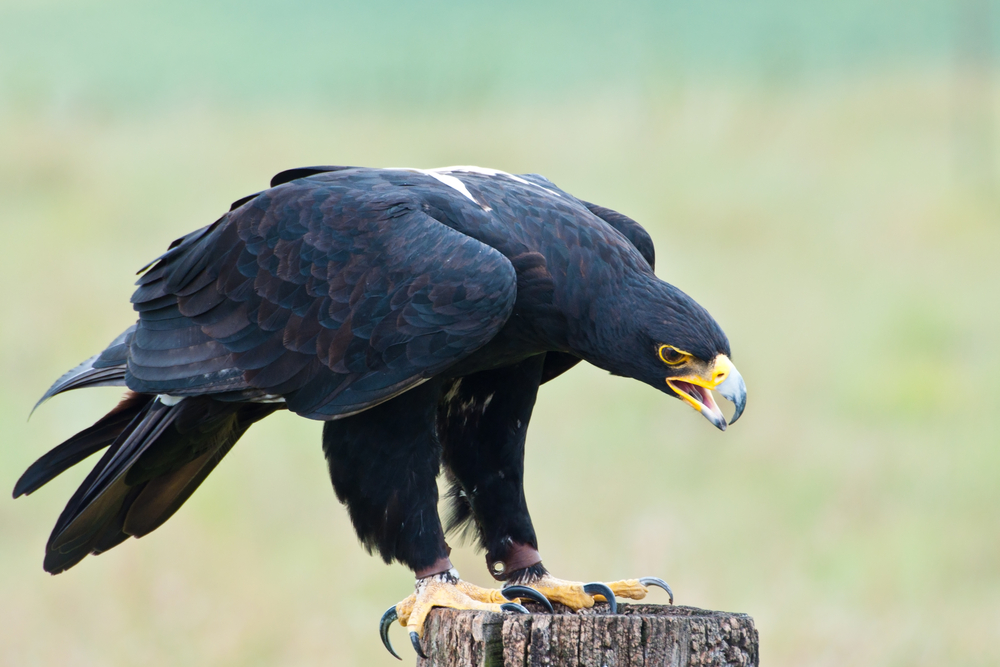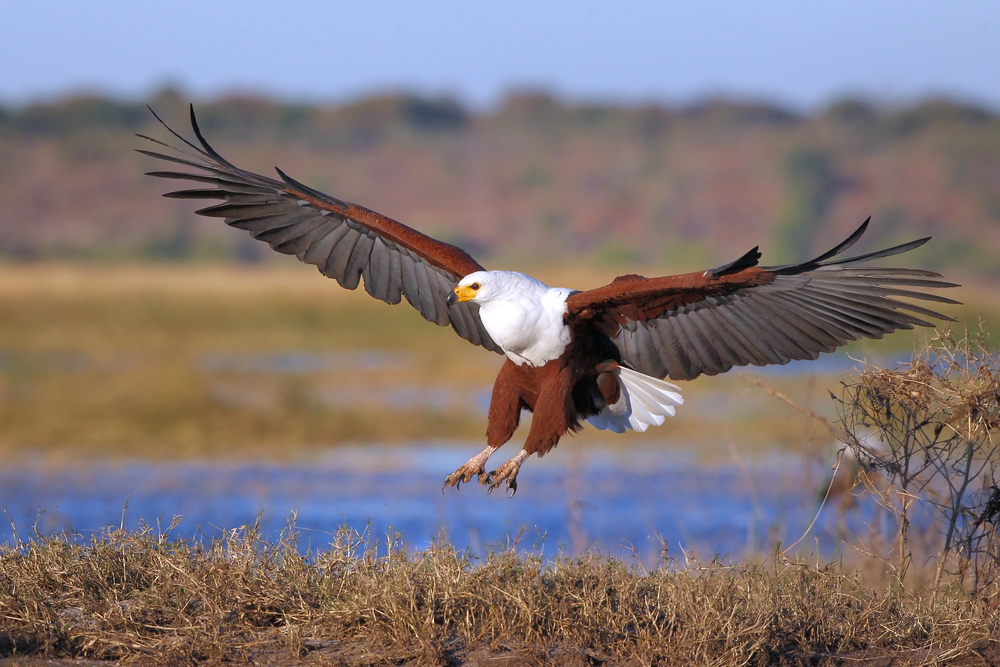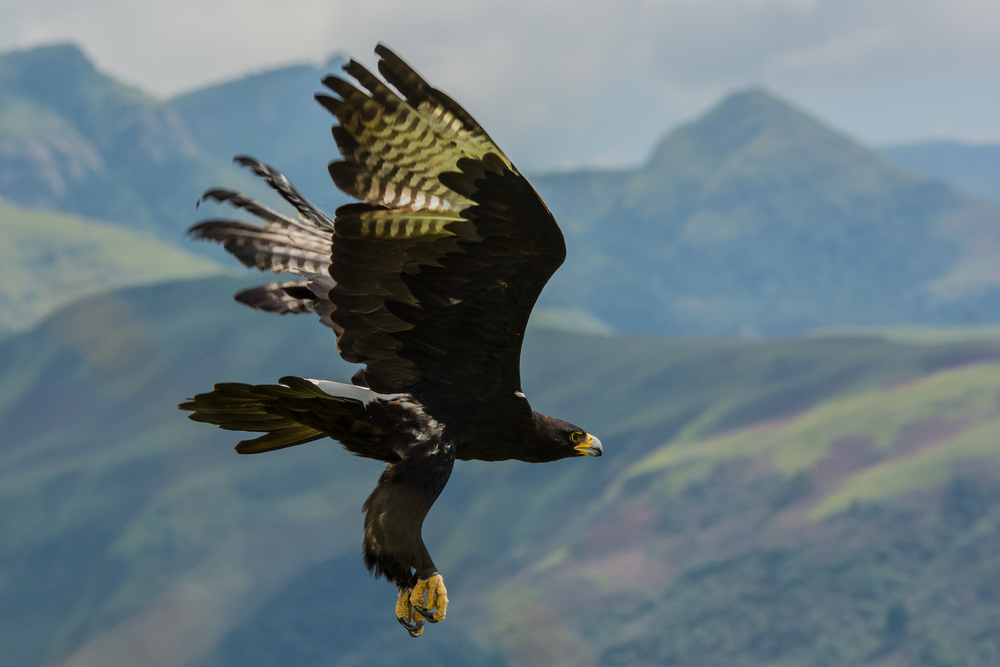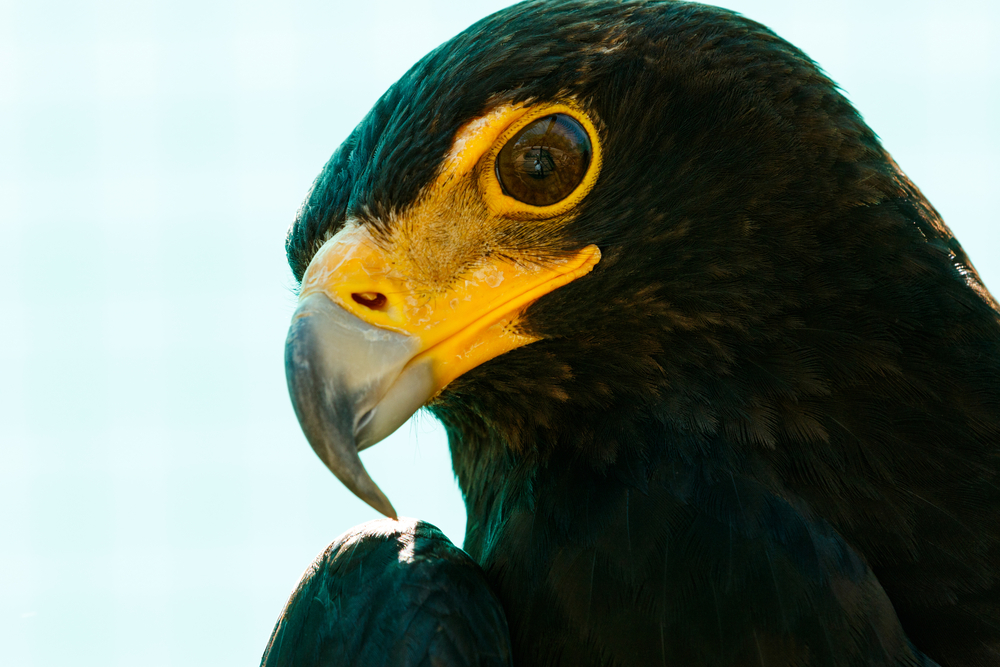About
The Black Eagle, scientifically known as Ictinaetus malaiensis, is a magnificent bird of prey renowned for its impressive size, agility, and striking appearance. Belonging to the family Accipitridae, which includes eagles, hawks, and kites, the Black Eagle occupies a prominent position in the Animal Kingdom as a formidable aerial predator.
With its sleek black plumage, powerful talons, and a broad wingspan that can exceed two meters, the Black Eagle cuts a striking figure in the skies. It possesses keen eyesight and a strong, curved beak, which it uses to spot and capture prey with remarkable precision. Known for its stealth and agility, the Black Eagle is a masterful hunter capable of pursuing a variety of prey species across diverse habitats.
Black Eagles inhabit dense forests and wooded areas across their range in tropical and subtropical regions of Africa and Asia. They are often observed soaring high above the canopy or perched on elevated vantage points, scanning the landscape for potential prey. These birds are primarily solitary and territorial, with each pair defending a vast hunting territory against intruders.
As opportunistic hunters, Black Eagles feed on a diverse array of prey, including small mammals, birds, reptiles, and even larger insects. They employ a variety of hunting techniques, from aerial stoops to stealthy ambushes, to capture their quarry. With their powerful talons and beaks, Black Eagles swiftly dispatch their prey before carrying it back to their nest or a nearby feeding perch.
Conservation Status
The conservation status of the Black Eagle varies depending on its geographic location. In some regions, populations may face threats such as habitat loss, deforestation, and human disturbance, leading to localized declines. However, the overall global population of Black Eagles is considered stable, and they are not currently listed as a threatened species on the IUCN Red List. Nonetheless, continued conservation efforts are essential for safeguarding their forest habitats and ensuring their long-term survival.
Physical Characteristics
The Black Eagle (Ictinaetus malaiensis) is a majestic bird of prey with distinct physical characteristics that set it apart in the avian world:
Size and Weight:
- Length: Black Eagles typically measure around 27 to 31 inches (69 to 79 centimeters) in length.
- Wingspan: They boast an impressive wingspan of approximately 60 to 70 inches (152 to 178 centimeters).
- Weight: Adult Black Eagles can weigh between 3 to 5.5 pounds (1.4 to 2.5 kilograms), with females being slightly larger and heavier than males.
Physical Characteristics:
- Plumage: As their name suggests, Black Eagles have predominantly black plumage covering their bodies. However, they also feature striking white markings on their wings and tail, which become more apparent during flight.
- Crested Head: Black Eagles have a distinctive crested appearance on their heads, characterized by a prominent crest of feathers atop their heads. This feature adds to their regal appearance and aids in species recognition.
- Powerful Beak: They possess a strong, hooked beak, ideal for tearing into prey and feeding on carrion. This sharp beak is a crucial tool for hunting and scavenging, allowing them to access a wide range of food sources.
- Strong Talons: Black Eagles have formidable talons that are adapted for gripping and immobilizing prey. These sharp, curved talons enable them to capture and carry prey items efficiently, including small mammals, birds, and reptiles.
- Agile Flight: With broad wings and a streamlined body, Black Eagles are exceptional fliers. They exhibit remarkable agility and grace in the air, soaring effortlessly on thermal currents while scanning the landscape below for potential prey.
These unique physical characteristics make the Black Eagle a formidable apex predator in its habitat, renowned for its prowess in the air and its striking appearance.
Reproduction
The reproductive cycle of the Black Eagle is intricately linked to its habitat and behaviors. Here’s an overview:
Breeding Season: Black Eagles typically breed during specific times of the year, which can vary depending on their geographic location. In some regions, breeding may occur year-round, while in others, it may be seasonal.
Courtship and Pair Bonding: During the breeding season, Black Eagles engage in elaborate courtship displays to establish and strengthen pair bonds. These displays may include aerial acrobatics, vocalizations, and mutual grooming.
Nest Building: Once pair bonds are established, Black Eagles construct nests in elevated locations such as tall trees or cliffs. The nest-building process involves collecting branches, twigs, and other materials to create a sturdy structure.
Egg Laying and Incubation: After the nest is built, the female lays a single egg, although occasionally, a pair may produce two eggs. The incubation period for Black Eagle eggs lasts around 40 to 45 days, during which both parents take turns incubating the egg.
Hatching and Chick Rearing: Upon hatching, the chick is initially helpless and relies on its parents for warmth and food. Both parents participate in feeding and caring for the chick, regurgitating food for it to consume.
Growth and Development: As the chick grows, it becomes increasingly active and begins to develop its feathers. The parents continue to provide food and protection, ensuring the chick’s survival during this critical period.
Fledging: After several weeks, the chick reaches a stage where it is ready to leave the nest, known as fledging. It may take its first flight attempts, gradually gaining confidence and strength in its wings.
Post-Fledging Care: Even after fledging, the young Black Eagle remains dependent on its parents for some time, as it continues to refine its flying and hunting skills. The parents provide guidance and support as the juvenile learns to navigate its environment.
Dispersal and Independence: Eventually, the juvenile Black Eagle gains independence from its parents and begins to explore its surroundings independently. It may disperse to new areas in search of suitable habitat and territories.
Maturity and Breeding Success: Black Eagles typically reach sexual maturity at around 4 to 5 years of age. Upon reaching maturity, they may establish their own territories and begin breeding, contributing to the ongoing cycle of reproduction in their population.
Conservation Considerations: Factors such as habitat loss, human disturbance, and environmental pollution can impact the reproductive success of Black Eagles. Conservation efforts focused on protecting their habitats and minimizing human disturbances are essential for ensuring their continued survival.
Lifespan
The black eagle, also known as the Verreaux’s eagle, is a majestic raptor found in sub-Saharan Africa. These birds of prey are known for their impressive aerial acrobatics and powerful hunting abilities. Here’s an overview of the black eagle’s lifespan and the threats it faces:
Wild Lifespan: In the wild, black eagles have an average lifespan of around 20 to 25 years. However, some individuals may live longer under favorable conditions with access to abundant prey and suitable nesting sites. The survival rate of young eagles is relatively low due to predation, competition, and environmental factors.
Lifespan in Captivity: Black eagles kept in captivity, such as in wildlife rehabilitation centers or zoos, may have slightly longer lifespans compared to their wild counterparts. In captivity, they receive regular meals, veterinary care, and protection from natural predators, which can contribute to their overall well-being and longevity. However, captive environments must provide ample space for flight and natural behaviors to ensure their physical and mental health.
Threats to Black Eagles:
- Habitat Loss and Degradation: Deforestation, urbanization, and agricultural expansion threaten the habitat of black eagles. Loss of suitable nesting sites and prey abundance can impact their reproductive success and survival.
- Human Disturbance: Human activities such as logging, mining, and recreational activities near eagle nesting sites can disturb breeding pairs and disrupt their nesting behavior. Disturbances during the breeding season may cause eagles to abandon their nests, leading to reproductive failure.
- Poaching and Persecution: Black eagles may be targeted by poachers or persecuted by humans due to misconceptions or conflicts with livestock owners. Shooting, trapping, and poisoning are significant threats to their survival, especially in areas where they are perceived as threats to livestock or game animals.
- Electrocution and Collision: Power lines and wind turbines pose risks of electrocution and collision for black eagles, particularly during flight. Poorly placed infrastructure in or near their habitat can result in fatalities and habitat fragmentation.
- Climate Change: Climate-related factors such as temperature increases, extreme weather events, and changes in precipitation patterns may impact the availability of prey species and suitable habitats for black eagles. Shifts in prey distribution and nesting site quality could affect their survival and breeding success.
Conservation efforts focused on habitat protection, community engagement, and reducing human-wildlife conflicts are essential for safeguarding black eagle populations and ensuring their long-term survival in the wild. Additionally, monitoring and research programs can provide valuable insights into their ecology and behavior to inform conservation strategies.
Eating Habits
The black eagle, also known as the Verreaux’s eagle, is a large bird of prey found in sub-Saharan Africa. As a formidable apex predator, the black eagle primarily preys on a variety of small to medium-sized mammals, birds, and reptiles. Its hunting prowess and aerial agility make it a formidable predator in its habitat.
Diet: Black eagles are carnivorous birds that primarily feed on a wide range of prey species. Their diet includes small to medium-sized mammals such as rodents, hares, and monkeys, as well as birds like guinea fowl, francolins, and pigeons. They are also known to hunt reptiles such as snakes and lizards. Black eagles typically target prey that is abundant and readily available in their habitat.
Hunting Techniques: Black eagles are skilled hunters that employ various hunting techniques to capture their prey. They often hunt from elevated perches, scanning the surrounding area for potential prey. Once a target is spotted, they swoop down with incredible speed and agility to seize their prey with their powerful talons. Alternatively, black eagles may engage in aerial pursuits, chasing prey in flight or ambushing them from above.
Territorial Behavior: Black eagles are territorial birds that defend exclusive hunting territories from other individuals. These territories often encompass prime hunting grounds with abundant prey resources. By maintaining exclusive territories, black eagles ensure a stable food supply and reduce competition for prey.
Feeding Behavior: After capturing prey, black eagles typically consume their kill at a secluded feeding site within their territory. They may tear apart the carcass using their sharp beaks and talons, consuming meat and organs while discarding feathers, fur, and bones. Black eagles may also cache excess food to consume later, particularly during times of scarcity.
Dietary Adaptations: The black eagle’s diet and hunting behavior may vary depending on factors such as habitat, prey availability, and seasonal changes. In some cases, they may opportunistically scavenge on carrion or steal kills from other predators such as leopards or hyenas. Additionally, black eagles may adjust their hunting strategies based on the behavior and movements of their prey species.
Conclusion: The black eagle’s carnivorous diet and hunting prowess make it a vital component of its ecosystem. As an apex predator, it helps regulate prey populations and maintain the balance of its habitat. Understanding the eating habits and ecological role of the black eagle is crucial for conserving this majestic bird and preserving the integrity of its habitat in sub-Saharan Africa.
Uniqueness
The Black Eagle, known scientifically as Ictinaetus malaiensis, is a striking raptor found predominantly in the forested regions of Asia. Here are some key aspects that make the Black Eagle unique:
Distinctive Appearance: The Black Eagle is characterized by its almost entirely black plumage, which gives it a commanding presence. The feathers have a subtle but distinctive grayish or brownish tinge on the underside, and the wings and tail can show faint banding. The bird’s striking golden eyes and sharp talons add to its fierce appearance.
Specialized Habitat: Unlike many other eagles that thrive in open or mixed landscapes, Black Eagles are highly specialized for life in dense forests. They are typically found in large, undisturbed forested areas, from lowlands up to mountainous terrains.
Tree-Top Hunter: Black Eagles have adapted their hunting techniques to the dense habitats they occupy. They are known for their exceptional ability to maneuver through trees, often flying close to the forest canopy to hunt for birds, squirrels, and other tree-dwelling animals. They have also been observed preying on bird eggs and nestlings, snatching them right from the nests.
Soaring Skills: This eagle is an adept flyer, known for its soaring capabilities. It utilizes thermal currents to glide gracefully above the forest, conserving energy during long flights. The broad wings of the Black Eagle are perfectly adapted for efficient soaring and sharp maneuvering through its forested home.
Monogamous and Territorial: Black Eagles are monogamous birds, often forming long-lasting pair bonds. They are also highly territorial, defending their chosen area fiercely against any intruders. The pair works together to maintain their territory and raise their young.
Nesting Habits: Their nests are large structures built high in the tree canopy, typically on emergent trees that stand above the general canopy level. These nests are used year after year, with both male and female contributing to the maintenance.
Vocalization: The vocalization of the Black Eagle is quite distinct — a series of whistling notes that are often heard during their soaring flights. These calls play an important role in communication, especially during the mating season and in territorial defense.
Conservation Status: The Black Eagle faces threats from habitat destruction and fragmentation due to logging and agricultural expansion. While not currently endangered, its dependence on large tracts of forest makes it vulnerable to deforestation and habitat loss.
The Black Eagle’s adaptation to forest life, unique hunting strategies, and the striking beauty of its dark plumage make it a fascinating subject for bird enthusiasts and an important species for conservation efforts within its natural habitat. Its presence underscores the ecological richness and biodiversity of Asia’s forest ecosystems.







































































